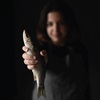Cooking with Cape Hake is always an absolute pleasure. It's a fish that is as sustainable as it is delicious, which means that future generations will get to enjoy everyone's favourite seafood!

Prep time
60 mins
Cooking Time
10 mins
Serves
6
Ingredients
For the fish cakes:
- 800g MSC certified hake loin fillets
- 500ml milk
- 2 cloves of garlic, crushed
- 1 bay leaf
- 3-4 large potatoes, peeled, boiled, mashed and chilled
- 1 egg, beaten
- 1 small onion or 2 shallots, finely chopped and excess liquid drained
- 2-3 sprigs of fresh parsley, finely chopped
- 2-3 sprigs of fresh chives, finely chopped
- 1 large lemon, zested
- 250ml plain flour
- Coarse ground sea salt and black pepper
- Coconut or any other neutrally flavoured oil, for frying
- Lemon wedges, for serving
- 300ml good quality mayonnaise
- 4-6 gherkins, finely chopped
- 7-8 capers, finely chopped
- 2 sprigs of fresh parsley, finely chopped
- 2 tablespoons lemon juice
- Coarse ground black pepper
Method
- Pour the milk into a saucepan and add the hake fillets, garlic and bay leaf.
- Poach the fish over medium heat for 8-10 minutes or until flaking. Carefully drain the hake, use a fork to flake the fish and set aside to cool.
- In a mixing bowl, combine the flaked hake, the mashed potatoes and beaten egg. Add in the onion, herbs and lemon zest and use a wooden spoon to combine. Season the mixture with salt and pepper.
- Line a baking sheet with greaseproof paper and set aside. Using clean hands, take roughly two heaped tablespoons of the mixture and roll into a ball that can fit within the palm of your hand. Flatten the ball into a patty, pressing in the mixture firmly.
- Arrange each 'viskoekie' (fish cake) on the baking sheet and once done, refrigerate for 20-30 minutes.
- For the tartare sauce, combine all the ingredients together and chill until required.
- Remove the fish cakes from the fridge and heat up about 2cm of coconut oil in a large frying pan. Dust each fish cake with seasoned flour and carefully place into the hot oil, taking care not to crowd the pan. The fish cakes should only require a few minutes on each side to brown. Once golden and crispy, drain the fish cakes on kitchen towel and sprinkle over some sea salt.
- Serve immediately with the tartare sauce and extra lemon wedges.
Did you know: 'Viskoekie' is the Afrikaans term for fish cake.


